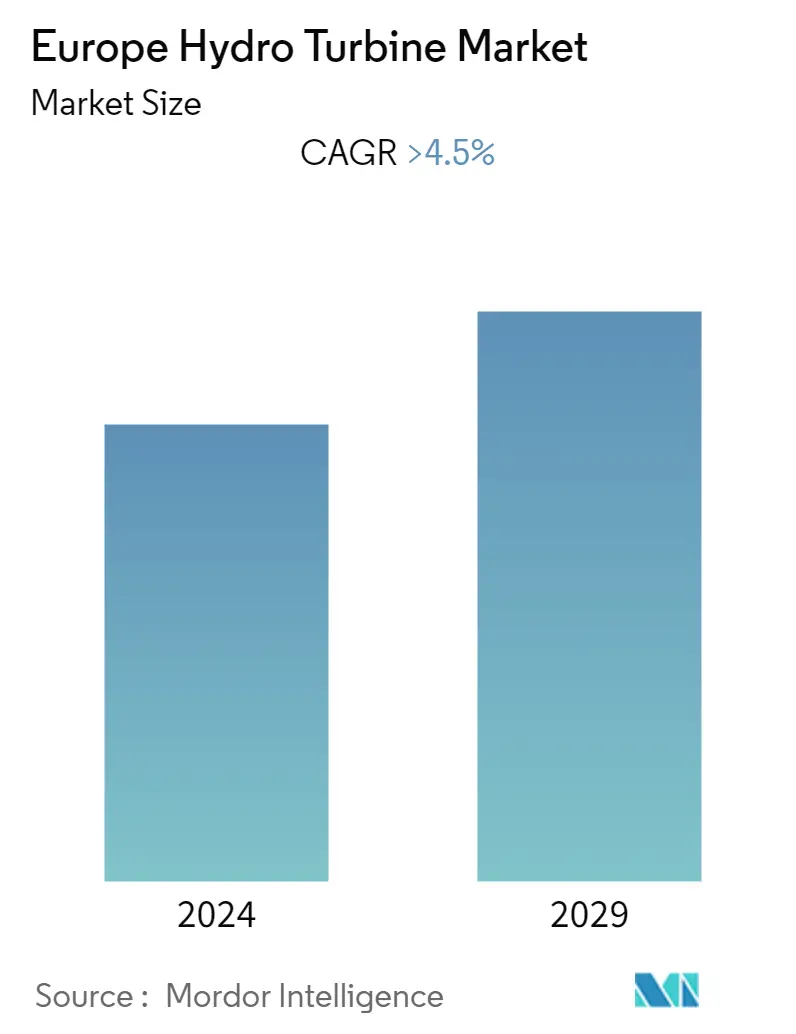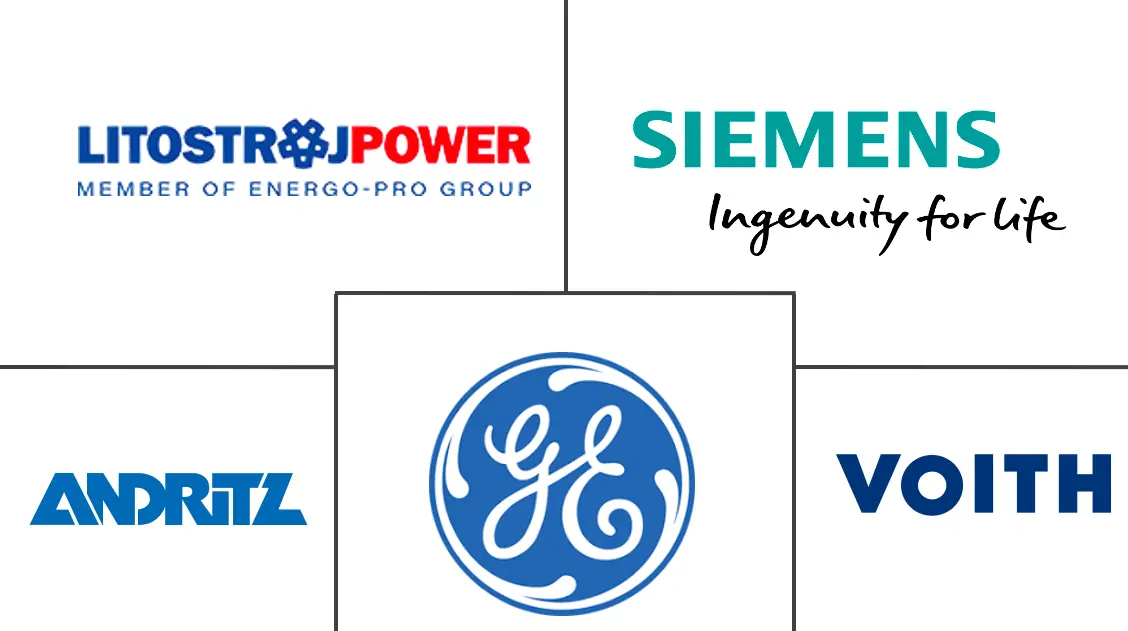Market Size of Europe Hydro Turbine Industry

| Study Period | 2021 - 2029 |
| Base Year For Estimation | 2023 |
| Forecast Data Period | 2024 - 2029 |
| Historical Data Period | 2021 - 2022 |
| CAGR | > 4.50 % |
| Market Concentration | Medium |
Major Players
*Disclaimer: Major Players sorted in no particular order |
Europe Hydro Turbine Market Analysis
Europe hydro turbine market is projected to register a CAGR of over 4.5% during the forecast period.
COVID-19 negatively impacted the market in 2020. Presently the market has now reached pre-pandemic levels.
- Over the medium term, factors such as increasing demand for energy, a rise in the need for cleaner technologies for power production, and stringent emission policy targets are likely to drive the hydro turbine market.
- On the other hand, certain drawbacks, such as design challenges of the turbine, ecological concerns related to dams, long gestation periods, and high installation cost of dams are hampering the growth of the studied market.
- Nevertheless, the rising requirement for renewable energy in emerging economies is anticipated to create a good growth opportunity for hydro turbine manufacturers. Emerging markets offer a potentially strong growth opportunity for renewable energy in the next few years.
- Norway is expected to be the largest market in the forecast period, with its high mountain plateaus, numerous natural lakes, steep valleys, and fjords, Norway's topography is well suited to hydropower development.
Europe Hydro Turbine Industry Segmentation
Hydro turbines are devices used in hydroelectric generation plants that transfer energy from moving water to a rotating shaft to generate electricity. Hydropower plants utilize these turbines to generate electricity as a result of the introduction of water to their blades. Hydropower is the process of generating power by using water to produce energy.
The hydro turbine market is segmented by technology, capacity, and geography. By technology, the market is segmented into reaction and impulse. By capacity, the market is segmented into small (less than 10MW), medium (10MW - 100MW), and large (greater than 100MW). The report also covers the market size and forecasts for the hydro turbine market across major countries in the region. The market size and forecasts for each segment have been done regarding revenue (USD billion).
| Technology | |
| Reaction | |
| Impulse |
| Capacity | |
| Small (Less than 10MW) | |
| Medium (10MW - 100MW) | |
| Large (Greater than 100MW) |
| Geography | |
| Germay | |
| United Kingdom | |
| Norway | |
| Italy | |
| Rest of Europe |
Europe Hydro Turbine Market Size Summary
The Europe hydro turbine market is poised for growth, driven by increasing energy demand and a shift towards cleaner power production technologies. The market has rebounded to pre-pandemic levels after the setbacks caused by COVID-19. Key factors propelling the market include stringent emission policies and the rising need for renewable energy sources, particularly in emerging economies. However, challenges such as the high costs and ecological concerns associated with dam construction, along with design complexities, pose obstacles to market expansion. Despite these challenges, the potential for significant growth in renewable energy markets presents lucrative opportunities for hydro turbine manufacturers. Norway stands out as a major player in the region, leveraging its favorable topography for hydropower development.
Large-scale hydropower plants, which are essential for generating substantial amounts of hydroelectricity, are categorized into various types, including conventional dams and pumped storage systems. While the initial installation costs are high, these plants offer low operational costs, making them economically viable, especially in urban areas. Hydropower remains a crucial component of Europe's energy landscape, being the second-largest renewable energy source in the region. Norway's hydropower system, with its extensive reservoir capacity and flexible production capabilities, plays a pivotal role in the country's electricity supply. The market is moderately fragmented, with key players like General Electric Company, Andritz AG, and Siemens AG actively participating in the sector. Recent developments, such as strategic collaborations and rehabilitation projects, underscore the ongoing advancements and investments in hydro turbine technology across Europe.
Europe Hydro Turbine Market Size - Table of Contents
-
1. MARKET OVERVIEW
-
1.1 Introduction
-
1.2 Market Size and Demand Forecast in USD billion, till 2027
-
1.3 Recent Trends and Developments
-
1.4 Government Policies and Regulations
-
1.5 Market Dynamics
-
1.5.1 Drivers
-
1.5.2 Restraints
-
-
1.6 Supply Chain Analysis
-
1.7 Porter's Five Forces Analysis
-
1.7.1 Bargaining Power of Suppliers
-
1.7.2 Bargaining Power of Consumers
-
1.7.3 Threat of New Entrants
-
1.7.4 Threat of Substitutes Products and Services
-
1.7.5 Intensity of Competitive Rivalry
-
-
-
2. MARKET SEGMENTATION
-
2.1 Technology
-
2.1.1 Reaction
-
2.1.2 Impulse
-
-
2.2 Capacity
-
2.2.1 Small (Less than 10MW)
-
2.2.2 Medium (10MW - 100MW)
-
2.2.3 Large (Greater than 100MW)
-
-
2.3 Geography
-
2.3.1 Germay
-
2.3.2 United Kingdom
-
2.3.3 Norway
-
2.3.4 Italy
-
2.3.5 Rest of Europe
-
-
Europe Hydro Turbine Market Size FAQs
What is the current Europe Hydro Turbine Market size?
The Europe Hydro Turbine Market is projected to register a CAGR of greater than 4.5% during the forecast period (2024-2029)
Who are the key players in Europe Hydro Turbine Market?
General Electric Company, Andritz AG, Litostroj Power Group , Siemens AG and Voith GmbH & Co. KGaA are the major companies operating in the Europe Hydro Turbine Market.

